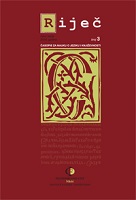Jотовање у рукописима Црногорског сената
Jotation in the Manuscripts of the Montenegrin Senate
Author(s): Sanja ŠubarićSubject(s): Theoretical Linguistics, Phonetics / Phonology, Montenegrine Literature, 19th Century, Theory of Literature
Published by: Filološki fakultet, Nikšić
Keywords: documents of the Montenegrin Senate; old (oldest) jotation; new (younger) jotation; Jekavski (youngest) jotation;
Summary/Abstract: This paper offers a review of specific features regarding the process of jotation in the documents of the Montenegrin Senate (the central administrative and judicial organ in Montenegro from 1831 to 1979; due to objective circumstances, the analysis has been restricted to the language in the Senate’s documents written in the period 1860–1879). The analysis has shown that in the manuscripts of the Senate the ProtoSlavic and the new jotation is mostly present in the groups labial + j – the nonjotated forms feature only sporadically; the dialect-induced break of the consonant clusters пљ, бљ, вљ and мљ, formed by the Proto-Slavic jotation, is reflected in certain toponyms and their derivations (Жуплна, Грбланина, Пјеваља), and it is also pertinent to some forms of the adjectival passive participles (глобјени, углавјени) and less frequently to forms of iterative verbs (јавјамо, окупјам), verbal nouns (живјење, непоразумјенi)...; the exceptions to the rule of the new jotation are reduced to the cluster бљ (робље ^ робје); jekavian jotation of the labial consonants is asserted by only about ten examples: the clusters пљ, вљ and мљ are limited to only one lexeme each (Пљенавац, живл%ла, спразумљети), and the cluster бљ features in various lexemes (пребљегу, обљешени, побљећи). According to these relations in the registered examples, and with regard to the condition in the Montenegrin speeches, we can assume that even the less educated correspondents of the Senate have also imitated the literary model in the official correspondence, thus overcoming the mixing of the dialects in the reflections of dated and recent groups labial consonant + j. In relation to the jekavian jotation of the dental consonants d and m, an inconsistency has been confirmed (виђети: видјети, ђетета : дјетета; исћера : истјера, хћели : хт%ли). Apart form the common jekavian forms, such as љето, прољеће, кољено..., there are also the forms of the words of foreign origin in which љ is the result of the analogical jotation (биљет, таљер). Jotation of the pronominal prefix н% is not frequent (њеки, њешто, нћколико). There are no graphemic confirmations of the fricatives с and з jotation before је < i, i.e. the pronunciation of the sounds с' and з' (Пресједник, сјеђаше; изјеле); the examples for assuming the pronunciation of the sound с' (Седоци) are quite rare.
Journal: Riječ
- Issue Year: 2010
- Issue No: 3
- Page Range: 61-79
- Page Count: 19
- Language: Serbian

